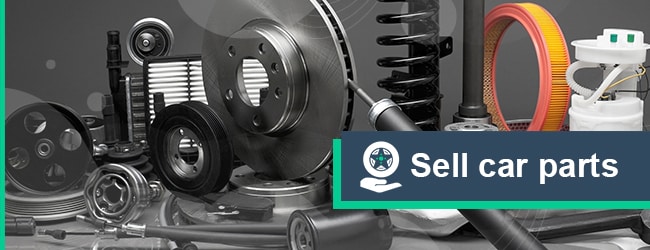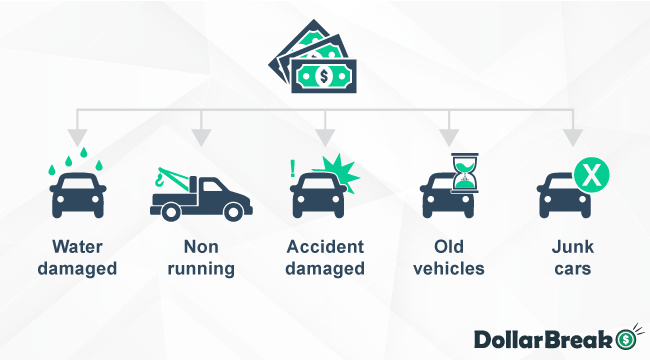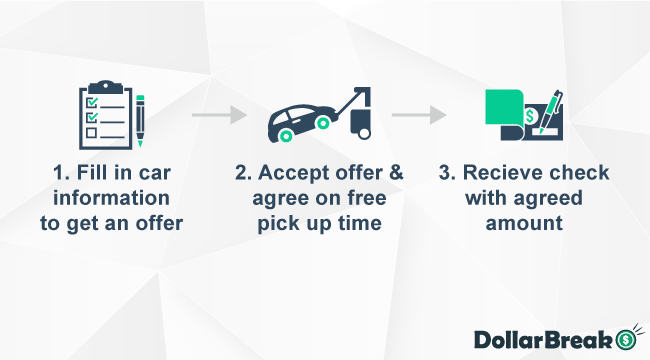Key Takeaways
- Peddle, Wheelzy and CarBrain are online platforms that buy cars in any condition, offering free towing and quick payment. They dismantle the vehicles and sell the parts, making it easy for you to sell your car for parts without the hassle of doing it yourself.
- Other options for selling car parts include junk and scrap yards, which buy vehicles for their parts and metal content. The price you get depends on factors like the demand for the part, its rarity, and its condition.
- Selling a car for parts can be a good option when the vehicle is non-repairable or requires repairs that cost more than the car’s value. However, parting out a car yourself can be time-consuming, taking 35-70 hours for disassembly, cleaning, and listing parts. If you lack experience, selling the whole car to a company like Peddle may be more profitable.
Best Used Car Buyers
Peddle

Trustpilot Rating
Get a legit offer in minutes – provide VIN, mileage and condition
$0 fees + you don’t have to pay for towing – Peddle will take care of it
Get paid in check during the pick up for any car (damaged, junk)
Wheelzy
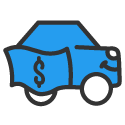
Trustpilot Rating
Quick car evaluation without the hassle – sell your car within 30 min
Choose a convenient date and time for free pick-up, even tomorrow
Get cash in hand the same day the Wheelzy agent picks up your car
Best Places to Sell Your Car for Parts:
1. Peddle
You can sell your car parts on Peddle by letting them buy your old car no matter the condition to get you quick cash. All you have to do is:
- Tell them about your car’s condition, its model, and year of manufacture by filling out an online form or calling them at (855) 925-4302
- Peddle will then present you with an offer instantly, but you have up to 7 days to think things through
- Accept the offer
- Once you have accepted the offer, Peddle will come tow the car for free at no additional cost. You will then get paid in cash or check.
2. Wheelzy
Wheelzy will also help you sell car parts by buying your car, no matter the condition, model, or make. With Wheelzy, you get the most money your car is worth. To know what the price will be, contact their customer team at (855) 510-1108 or fill out an online form to get an instant offer.
The offer includes a car removal fee, meaning there is no additional cost. Once you accept the offer, you arrange the pick-up time with them. Consequently, the expert team pays the agreed amount upon arrival in cash or check, with no baits or switch-ups.
3. CarBrain
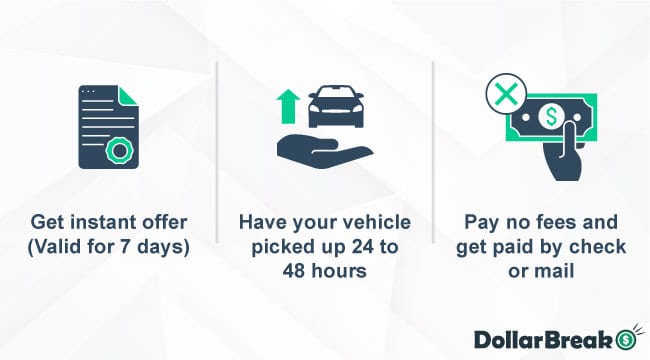
CarBrain is a US-based nationwide dealer that buys cars that are not in the best condition and repurposes them for parts. Selling car parts to CarBrain is a fast and efficient process as the company is renowned for providing instant offers on most cars, and payment is made shortly after in 24 to 48 hours.
Selling your car parts to CarBrain is a three-stage process. You will need to:
- Fill out your online application at CarBrain. After giving details about your car, CarBrain will analyze your request and send you an offer in less than 24 hours.
- CarBrain gives you up to 7 days to decide whether to accept or reject the offer. If you choose to accept, you will hand over the car’s keys, title, and access.
- CarBrain will then pay you and pick up the car 48 hours after you accept the offer
Selling your vehicle to CarBrain is a free process; if anything, CarBrain pays you. Carbrain rids you of the process of parting out your junk car and other professional costs. In fact, it will only take you 90 seconds if you choose their online offer. The amount you get from the sale of a vehicle depends on factors such as;
- The condition of the vehicle
- The age of the vehicle
- The make and model of the vehicle

Other Places to Sell Car Parts for Cash:
4. Junk and Scrap Yards
Junkyards present a viable and lucrative option for selling car parts. These establishments primarily deal with vehicles that are beyond repair, dismantling them for parts that are then sold to various customers, ranging from individual buyers to repair shops.
Selling car parts to these yards can prove beneficial, especially if you have parts from older models that are hard to find in the market or parts from cars that are totaled or non-functional. You may choose to remove the parts yourself or bring in the entire vehicle for dismantling.
The offer value depends on the following:
- Demand for part
- The rarity of the part
- Part’s condition
Junkyards are also making money, so they will aim to acquire your parts at the lowest cost possible. Therefore, prior knowledge of the worth of your parts is crucial to ensure fair negotiation. Check the prices of similar parts online or get estimates from multiple yards for comparison.
5. Scrap Metal Yards
Unlike junkyards, which focus primarily on reselling usable parts, scrap metal yards are interested in the metal content of the car parts. They purchase these parts to recycle the metal, making it a more eco-friendly alternative to traditional waste disposal.
Parts that are most valuable:
- Engine (includes iron, steel, aluminum, and copper)
- Transmission (includes iron, steel, and aluminum)
- Catalytic converter (includes platinum, palladium, and rhodium)
- Battery (includes lead)
To get started, identify a reputable scrap metal yard in your area. From there, arrange for an evaluation of the parts you have. Similar to auto salvage yards, the price you get depends on various factors, including the current market rates for different metals and the condition and weight of the parts.
Average Prices of Car Parts
The cost of car parts varies dramatically based on whether they are new or used, the specific type of part, the brand or model of the vehicle they belong to, and their availability in the market.
On average, used car parts can cost anywhere from 20% to 80% less than new parts. However, the degree of cost-saving often depends on the type of part in question.
| Part | Used | New |
|---|---|---|
| Engine | $500-$5,000 | $2,000-$10,000 |
| Transmission | $1,000-$3,000 | $2,500-$7,500 |
| Catalytic converter | $200-$500 | $500-$1,000 |
| Battery | $100-$200 | $150-$250 |
| Wheels and tires | $50-$500 | $100-$200 |
| Rearview mirrors | $50-$100 | $100-$200 |
Who Buys Car Parts?
Car parts, new or used, find a broad and varied audience, spanning individuals and entities alike. Understanding who these potential buyers are can help you tailor your strategy and pricing to meet their specific needs and preferences.
Each type of buyer in the automotive market has distinct needs, influencing the specific parts they are inclined to purchase. For example, a DIY mechanic might buy a used car part to save money, while a professional mechanic might buy a new car part to ensure quality.
The buyer’s location will also affect where they buy car parts. For example, someone who lives in a rural area might have to buy car parts from a junkyard or salvage yard, while someone who lives in a city might be able to buy car parts from an auto parts store or online retailer.
Types of car part buyers:
- Professional mechanics – prioritizes quality and reliability and requires a regular inflow of car parts. Same-day or fast delivery options appeal to most due to the time-sensitive nature of their work.
- DIY mechanics – search for new and used components to carry out repairs or modifications. Often lingers toward cheaper options.
- Car dealerships – need a steady supply of quality parts. They primarily opt for new parts but may use quality used parts for older models or cost-conscious customers.
- Insurance companies – source car parts for vehicles they insure following an accident or damage. Often need a wide variety of parts, ranging from body parts to mechanical components.
- Auto body shops – primarily deal with body parts like panels, bumpers, and mirrors but can also require a range of other parts depending on the repair work.
- Retail consumers – non-mechanical individuals who purchase car parts for replacements or upgrades. Ease of installation and clear, understandable product descriptions are key selling points for this group.
Pros and Cons of Selling Car Parts
Selling car parts can be a profitable venture, but like all business endeavors, it comes with its own set of advantages and challenges. Here are some key pros and cons to consider:
Pros of selling car parts:
- Profitability – selling price can often exceed the scrap value of an entire car, especially the rare parts or parts from high-end models.
- Market demand – there’s a robust market for both new and used car parts, driven by DIY enthusiasts, professional mechanics, car restoration hobbyists, and other industry sectors.
- Environmental impact – selling used car parts promotes recycling and reduces the number of whole vehicles sent to the junkyard, contributing to waste reduction and environmental sustainability.
- Space clearing – if you have an old vehicle or multiple old parts in your garage taking up space, selling the parts can clear up your property while also making money can be a wise choice.
Cons of selling car parts:
- Time-intensive – the process of dismantling a vehicle can take 15-25 hours if you are competent. Further process of assessing parts, listing them for sale, and handling inquiries and transactions will also take additional time.
- Requires knowledge and skills – you must know how to safely and efficiently dismantle vehicles, identify valuable parts, assess their condition, and price them competitively. Doing it without any experience will result in extra hours and potential safety hazards.
- Variable demand – not all parts sell quickly, and some may sit for a long time before finding a buyer, especially if they are for less popular or older models.
- Storage – until sold, car parts need to be stored somewhere. This can take up considerable space, especially for larger parts or if you’re dealing with multiple vehicles.
- Regulations – local laws and regulations related to dismantling vehicles and selling parts that you must comply with, involving obtaining permits and adhering to environmental standards, might cost extra and complicate the whole process.
- Risk for lower returns – if parts are damaged during the dismantling process or don’t sell, you could end up making less money than if you sold the whole car to a junkyard.
In conclusion, while selling car parts has the potential for good profits and positive environmental impact, it will require professional experience, extra time and investments. It’s crucial to weigh these factors, build the necessary skills, and understand the market before diving in.
How to Sell Car Parts:
1. Choose The Most Profitable Parts to Sell
When you are looking to sell car parts, it’s important to choose the most profitable parts. Factors to consider:
- Demand – is one of the most important factors affecting profitability. If there is a high demand for a part, you can sell it for more money; if demand is low, you might experience loss.
- Condition – similar to demand, the condition affects how much you can make selling parts. A part in good condition will be worth more than a part in poor condition.
- The rarity of the part – a part that is rare or hard to find will be worth more than a part that is common. This increases your chances to sell it and make a profit
- Cost—you need to check the demand for the part and evaluate whether you will be able to sell it for more than you paid and whether the profit is enough to cover your venture’s additional expenses.
First, research market prices to find the best car parts to sell. Browse listings on eBay Motors, Craigslist, Facebook Marketplace, or specialized auto parts websites to see how much similar parts are selling for. Check both new and used prices to get a range of potential values.
Car parts that are frequently needed for repairs is always in high demand. Moreover, parts from popular vehicle models would also be a great option.
List of most popular car parts:
| Engine | Mechanical | Interior | Exterior |
|---|---|---|---|
| Alternators | Brake Pads | Seats | Bumpers |
| Oil Filters | Shocks and Struts | Steering Wheels | Fenders |
| Spark Plugs | Suspension Arms | Dashboards | Headlights |
| Timing Belts | Tie Rod Ends | Center Consoles | Taillights |
| Air Filters | Bearings | Door Panels | Door Mirrors |
| Fuel Injectors | Axles | Radio/Stereo Systems | Windshields |
| Cylinder Heads | Driveshafts | Airbags | Grilles |
| Camshafts | Control Arms | Seat Belts | Hoods |
| Pistons | Fuel Pumps | Carpeting | Trunk Lids |
2. Know Your Target Audience
When building a business to sell car parts understanding your target audience is critical for your success. Are you selling to businesses (B2B) or to consumers (B2C)? Both segments have unique characteristics and considerations.
B2B Buyers: typically professional auto repair shops, dealerships, or insurance companies. They generally buy parts in larger quantities and can provide steady business if they choose you as a regular supplier. The challenge here is that B2B sales often require more upfront work: building relationships, negotiating contracts, and ensuring a consistent supply.
B2C Buyers: DIY enthusiasts, car owners who need replacement parts, or individuals restoring old cars. Selling directly to consumers usually involves smaller quantities per sale, but you have a wider audience. The challenge in B2C is that you’ll need to invest time and money in marketing to reach your audience and competition can be fierce.
| Type | Pros | Cons |
|---|---|---|
| B2B | Larger orders, predictable business, recurring sales | Requires relationship-building, complex sales process |
| B2C | Wider audience, direct feedback, potential for higher margins | Requires marketing, high competition, smaller orders |
3. Find a Reliable Supplier
Finding a reliable supplier can make a significant difference in your business’s success. This is especially critical if you’re not sourcing the parts from your own vehicles. A reliable supplier is one that provides high-quality parts, delivers on time, and offers competitive prices.
Types of suppliers:
| Type of supplier | Pros | Cons |
|---|---|---|
| Original manufacturer | Provide genuine parts, offer warranties, have a good reputation | Can be expensive, not always available, may not be the best option for all repairs |
| Aftermarket suppliers | Offer a wider range of parts, can be less expensive, more readily available | May not be as high quality as original parts, may not offer warranties |
| Salvage yards | Can be a great source for used parts, often very affordable, can be a good option for hard-to-find parts | Parts may be damaged or worn, may not be the best option for all repairs |
| Online retailers | Convenient, often have a wide selection of parts, can be less expensive than brick-and-mortar stores | Can be difficult to verify the quality of the parts, may not offer warranties |
Quality of the Parts
The quality of the parts you sell directly affects your reputation. Whether you’re selling new or used parts, they should be in good condition and function as expected. Find suppliers that can provide warranties or guarantees on their parts.
Consistent Supply
Make sure the supplier can consistently provide the parts you need in the volumes you require. They should also be able to manage out-of-stock situations effectively to avoid unnecessary delays. It is a wise decision to have 2 or three suppliers that can back up each other. Make sure the supplier can assure timely and reliable delivery times.
Competitive Pricing
The price you pay for parts affects your bottom line. Look for suppliers that offer fair, competitive prices without compromising on quality. Remember, the cheapest supplier isn’t always the best if their parts are subpar or they’re unreliable.
Customer Service
They should be easy to contact, responsive to queries, and helpful in resolving any issues.
4. Choose a Sales Channel
Once you have your car parts, you need to decide where you’re going to sell them. There are a number of different sales channels available, each with its own pros and cons.
Here are a few of the most popular sales channels for car parts:
- Amazon
- eBay Motors
- Via your online store
Selling on Amazon
Amazon has over 197 million monthly active users and offers a number of features that can help you sell your parts.
Amazon will charge you a commission on each sale: for Automotive Parts and Accessories (not including Tires & Wheels) category – 12%, for the Tires & Wheels category – 10%. However, the fees are typically lower than what you would pay on other platforms.
Amazon’s product listings are optimized for search, so your parts are more likely to be found by potential buyers. Amazon also offers to store your products at their warehouse and handle shipping for you.
Selling on eBay Motors
eBay Motors has 138 million active users, and it offers a number of features that can help you sell your parts.
eBay Motors will also charge you a commission on each sale; The final value fee you will pay: is 13.25% on the total amount of the sale up to $7,500 per item, plus 2.35% on the portion of the sale over $7,500 and $0.30 per single order.
According to eBay Motors, “3 parts or accessories are sold every second“, and “14 complete engines are sold every hour”, making it a great option to consider.
Selling via Your Online Store
If you want more control over the sales process and pricing and to be an independent salesperson, you can create your own online store to sell your car parts.
If you want more control over the sales process, you can create your own online store to sell your car parts. This gives you more control over the pricing, product listings, and shipping options.
To create an online store, you’ll need to choose a platform, such as Shopify or WooCommerce. These are two of the most popular e-commerce platforms, and they offer a variety of features that can help you sell your car parts.
Once you’ve chosen a platform, you’ll need to purchase a domain name and web hosting. A domain name is your store’s address on the internet, and web hosting is the service that stores your store’s files and makes them accessible to visitors.
The next step is setting up your store: adding products, creating product listings, and setting up shipping and payment options.
To promote your products, use social media, email marketing, and paid advertising to reach potential buyers.
5. Choose the Shipping Method
Selecting the correct shipping method for your car parts business directly impacts customer satisfaction, reputation, and bottom line. How you deliver your products speaks volumes about your business’s reliability and efficiency.
Dropshipping and Fulfillment Services
This method eliminates the need to handle or store inventory, making it an excellent choice for businesses with limited storage space or resources. When a customer orders, the supplier or a third-party fulfillment center packs and ships the product on your behalf. This is particularly beneficial if you have a wide range of products or are selling heavy or bulky items that would be expensive to store and ship independently.
For example, the Fulfillment by Amazon (FBA) service takes care of storage, packing, and shipping, freeing up your time to focus on other aspects of selling your products on Amazon.
It’s essential to remember that while this method can save you time and effort, it can also result in less control over the shipping process and the customer experience.
Couriers
Couriers like FedEx, UPS, or DHL offer speedy and reliable shipping services, which can be crucial when customers require parts urgently, like professional mechanics or car dealerships. They also provide tracking information, which helps to keep the customers informed and builds trust.
Couriers can deliver heavy packages, including car engines or other car parts, but these items may be subject to additional handling fees due to their weight and size.
Each courier service has its weight limit for standard services. For instance, UPS accepts packages up to 150 lbs (68 kg), and FedEx accepts packages up to 150 lbs (68 kg) for their standard services.
These courier services offer freight services for items heavier than these limits. Freight shipping is designed for heavy and large items and can be used for both domestic and international shipping.
Although couriers can be more expensive than standard postal services, the additional cost can be worthwhile for ensuring customer satisfaction, particularly for higher-value parts.
Customer Collection
If you plan to have a physical store or warehouse and your primary customer base is local, offering a customer collection option can be an excellent way to save on shipping costs. It provides instant gratification for customers who need the parts urgently and can also drive additional sales if customers make impulse purchases when they come to collect their items.
It’s worth noting, however, that this method is less suitable for businesses targeting a wide geographical area.
People Also Asked
When is it worth selling a car for parts?
The moment when it’s worth selling a car for parts depends on a few factors:
- Non-repairable vehicle – when your car is non-running or has significant damage that makes it unfeasible to repair, selling it for parts might be the only option you will have.
- Expensive repairs – if your car requires repairs that cost more than the car’s value, selling it for parts could yield more money than selling it as a whole.
Is it worth tearing down the car?
Whether it is worth tearing down a car to sell the parts depends on a few factors, including the make and model of the car, the condition of the parts, and your willingness to put in the time and effort.
In general, if the car is a popular model with in-demand parts, and the parts are in good condition, you can expect to get more money by parting out the car. However, this process can take a significant amount of time and effort. You must disassemble the car, clean and inspect the parts, and then list them for sale online or at a salvage yard.
How long it can take:
- Disassembling the car: 20-40 hours
- Cleaning and inspecting the parts: 10-20 hours
- Listing the parts for sale: 5-10 hours
If you do not have the time or inclination to part out the car yourself, the best decision would be to sell it as a whole to Peddle.
What does a parts-only title mean?
A parts-only title signifies that a vehicle has sustained extensive damage, rendering it unrepairable. Such cars cannot be registered for on-road use and can only be sold for disassembly.
Can you make money selling car parts?
Selling individual car parts can be profitable if you have experience disassembling vehicles and an in-depth understanding of car parts and their engineering.
However, if you lack those skills, the process can take a lot of additional time, and consequently, any potential profits might not compensate for the expenses incurred.
To avoid hassle and get paid instantly, sell the car to Peddle, Wheelzy or Carbrain instead.


